|
|
|
|
|
 |
|
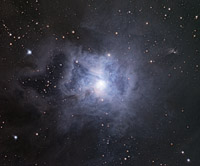 |
|
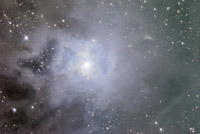 |
| M101 - otherwise known as the Pinwheel Galaxy. This
is a PhotoShop processed image, LRGB with exposure of 30 x 15 x 9 x 18
in minutes. Published at StarshipAsterisk* - forum for APOD. |
|
NGC 7023, the Iris Nebula. The original LRGB FITS
images (30 x 15 x 9 x 18) were processed using digital filters in MaxIm
DL and Mira Pro to bring out internal cloud detail. |
|
Here is the same image of the Iris Nebula, 'mega'
enhanced with PhotoShop CS2 to bring out the surrounding cloud details. |
|
|
|
|
|
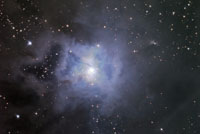 |
|
 |
|
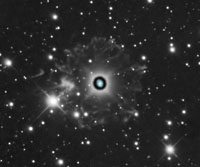 |
|
NGC 7023 - otherwise known as the Iris Nebula. This
is an LRGB image, 30 x 15 x 9 x 18 in minutes. Image processing was done
with PhotoShop CS2. The blue image was taken on a different optical
system. |
|
I learned the Cat's Eye Nebula is a difficult object
to photograph. The luminance is a 30 minute image, but the nebula itself
is over-exposed. The color portion of the nebula is an RGB image of 15 x
9 x 18 in seconds. |
|
This is a detail of the Cat's Eye Nebula. The color
image is the nebula we all know and love (see my
logo), but the surrounding wisps of gas are also a
part of the nebula. |
|
|
|
|
|
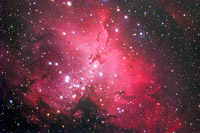 |
|
 |
|
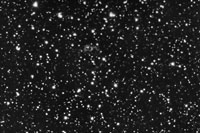 |
| M16 - the Eagle Nebula. This is my first LRGB image.
The image is a total of 72 minutes (30 x 15 x 9 x
18). Image processing was done with PhotoShop CS2.**Published: Astronomy.com Image of the Day** |
|
This is a color image (RGB images captured later) of
radio source Coma A. This is a 10 minute image (RGB
image is 5 x 3 x 6 in minutes). More detail on this
object can be found
here. |
|
This is an image of the faint supernova remnant -
Cassiopeia A. This is a 10 minute monochromatic image. This object was
detected first by its strong radio emission, which is why it is
designated 'A.' More detail on this object can be found
here. |
|
|
|
|
|
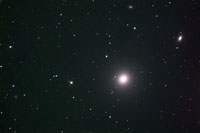 |
|
 |
|
 |
|
This is a color image of M84 (color images captured
later). This is a 10 minute luminance image with an RGB component of 5 x
4 x 6 in minutes. M84 is a prominent member of the Virgo Cluster, with
some of the other galaxies seen in the image. More information on this
object can be found
here. |
|
This is NGC 4261, a prominent member of the Virgo
Cluster (like M84). This is a 15 minute monochromatic image which was
affected with a strong gradient (a light was left on in the
observatory). Careful and time consuming image processing has removed
the gradient. More information on this object can be found
here. |
|
Here is a monochromatic image of open cluster M67.
This is a combination of 18 images, from 5 seconds
to 90 seconds (every 5 seconds) - the purpose of
which was to determine the light curve. The
combination of images does a very nice job in
removing noise, so much so that a tiny galaxy is
seen near the center of the image. Can you find it? |
|
|
|
|
|
 |
|
 |
|
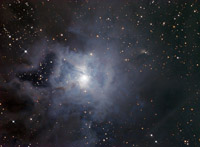 |
|
This is M1 - the Crab Nebula. This is a supernova
remnant of a star that is believed to have gone
supernova in the year 1054. Chinese astronomers
cataloged this star as a "guest star." This is the
first image I took on this telescope. The image
exposure was a mere 5 minutes, but PhotoShop CS2
does a nice job in bringing out the details. |
|
This is a re-process of the Cat's Eye Nebula.
Officially known as NGC 6543, the Cat's Eye Nebula
is a planetary nebula - the ending of a normal star
like our Sun. This particular nebula is about 3,000
light-years from Earth, situated in the region of
the constellation Draco. The orientation of the
lobes suggest that this was a double-star system,
with an unseen companion still orbiting the nebula. |
|
A lesson learned: more images of the same exposure equals lower noise and greater ability to bring out details in processing. This image uses the same image of the Iris Nebula from the 20" RC Optical Scope, but also includes three additional images of each luminance, red, green and blue (taken with a 12"). In other words: 4x30 Luminance, 4x15 Red, 4x9 Green and 4x18 Blue. I have to wonder what it would look like with more images! |
|
|
|
|
|

